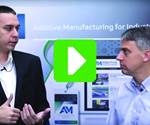Video: Moldmaker Succeeding with Conformal Cooling
B&J Specialty now complements its machining capabilities with metal 3D printing for making mold inserts with cooling channels that follow the contours of the mold. The shop is even revisiting challenging molds from the past.
B&J Specialty of Wawaka, Indiana, now complements its machining capabilities with metal 3D printing for making mold inserts that have conformal cooling channels—meaning channels that are not straight drilled holes, but instead follow the contours of the mold. The superior cooling that results improves the performance of the mold. The effect has been so dramatic that B&J is now revisiting challenging molds from the past. The company’s Jarod Rauch talked about this with me in a conversation we filmed at the Additive Manufacturing Conference.
Transcript:
Peter Zelinski, Additive Manufacturing
Welcome! You’ve unlocked premium content.
I’m Pete Zelinski with Additive Manufacturing magazine and I am here with Jarod Rauch, who is the additive division manager of B & J Specialty, a maker of molds, dies, specialty tooling….
Jarod Rauch, B&J Specialty
Our machining capability consists of three-, four- and five-axis machining, and high-speed machining.
Peter Zelinski
And yet increasingly you're making mold tooling additively, [through] metal 3D printing.
Jarod Rauch
With the use of conformal cooling technology, we can now optimally cool our product. Typically, conventionally, the method used was drilling waterline holes in a straight-line fashion. So if the geometry was not a very uniform shape and you did not have line-of-sight to be able to drill a typical hole to get water into that geometry, that created a problem. Conformal cooling, when applied correctly, can be amazing in what it can accomplish in the cooling properties. It is following the three-dimensional shape, maintaining uniform temperature throughout the entire geometry. When you're able to achieve that, many things start to happen. Productivity increases.
Peter Zelinski
You mean productivity at the molding machine making the plastic part….
Jarod Rauch
Yes.
Peter Zelinski
[Tell me] the additive machine you use, who supplied it to you and what alloy you are commonly printing in.
Jarod Rauch
Methods 3D helped us deploy a 3D Systems Pro-X 300 into our facility; we are currently using maraging steel.
Now you have the capability of entering into the geometry and then curving in, following the three-dimensional shape, achieving cooling into those areas that would typically be the problematic area. We’re looking at builds that we have done several years ago. Now we can go back to those problematic issues and we can correct those. With additive, you can look at things a totally new way. You can design for the optimal part rather than designing based on how you’re going to manufacture.
Related Content
-
How Norsk Titanium Is Scaling Up AM Production — and Employment — in New York State
New opportunities for part production via the company’s forging-like additive process are coming from the aerospace industry as well as a different sector, the semiconductor industry.
-
Hybrid Additive Manufacturing Machine Tools Continue to Make Gains (Includes Video)
The hybrid machine tool is an idea that continues to advance. Two important developments of recent years expand the possibilities for this platform.
-
Machine Tool Drawbar Made With Additive Manufacturing Saves DMG MORI 90% Lead Time and 67% CO2 Emission
A new production process for the multimetal drawbar replaces an outsourced plating step with directed energy deposition, performing this DED along with roughing, finishing and grinding on a single machine.











